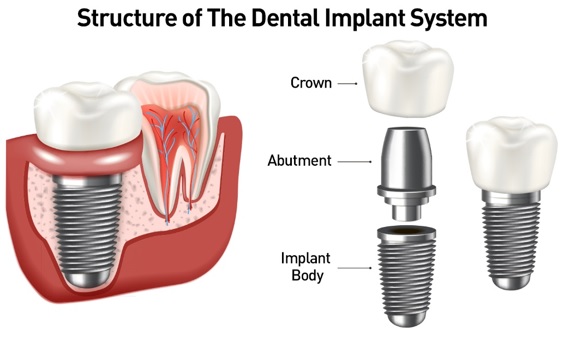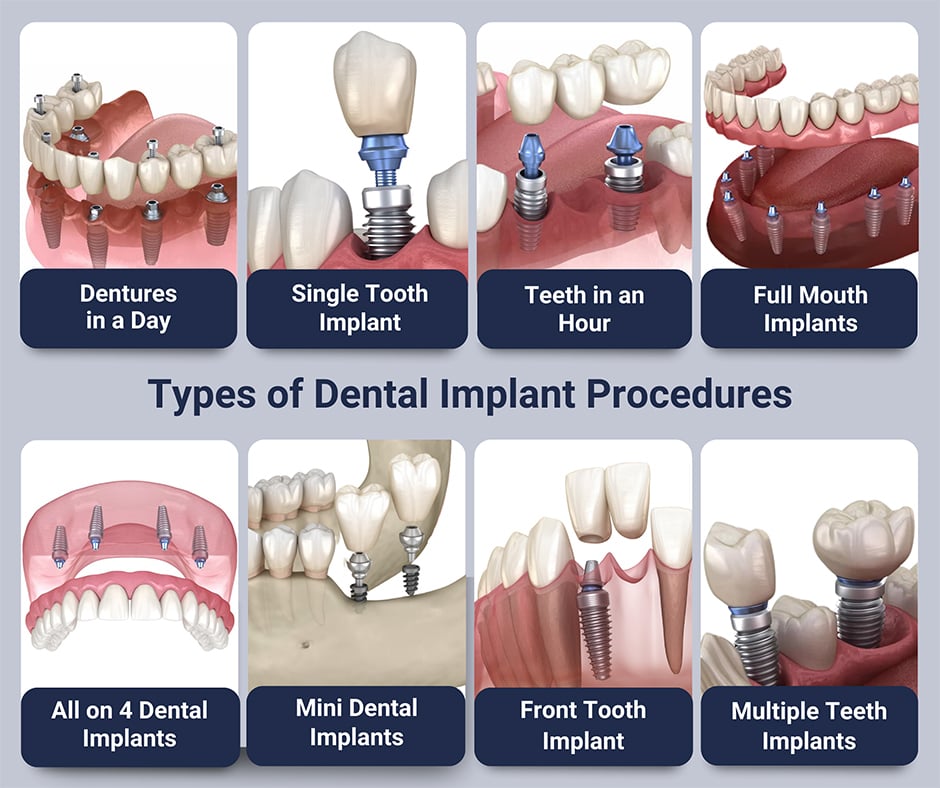Dental Implants for Dummies
5 Simple Techniques For Dental Implants
Table of ContentsDental Implants Can Be Fun For EveryoneThe 2-Minute Rule for Dental ImplantsWhat Does Dental Implants Do?Not known Facts About Dental Implants
are clinical devices operatively implanted into the jaw to bring back an individual's capability to eat or their appearance. They offer support for artificial (phony) teeth, such as crowns, bridges, or dentures. When a tooth is lost because of injury or disease, a person can experience issues such as fast bone loss, malfunctioning speech, or adjustments to eating patterns that result in pain.
Structure of The Dental Implant System choosing oral implants, speak with your oral company regarding the potential benefits and risks, and whether you are a candidate for the treatment. Things to consider: Your general wellness is a crucial factor in establishing whether you are an excellent prospect for oral implants, for how long it will require to recover, and the length of time the implant may remain in area.
Smoking might impact the recovery process and reduce the lasting success of the implant. The recovery procedure for the implant body might take a number of months or longer, throughout which time you commonly have a temporary abutment in place of the tooth. the oral implant procedure: Thoroughly comply with the dental health instructions provided to you by your dental copyright.
Fascination About Dental Implants
Implant failure can lead to the need for an additional operation to repair or replace the implant system. Restores the capacity to eat Restores aesthetic look Helps maintain the jawbone from diminishing due to bone loss Maintains the health and wellness of the bordering bone and periodontals Helps maintain adjacent (nearby) teeth stable Boosts lifestyle Damage to surrounding natural teeth throughout dental implant positioning Injury to the surrounding tissues during surgical procedure, such as sinus perforation Injury during surgical procedure (for instance, crack of surrounding jawbone) Insufficient feature, such as feeling like the teeth do not bite together generally An experience that the tooth hangs or twisting in location arising from an abutment screw loosening up Implant body failing (looseness of the implant body) because of systemic infection, which might be more most likely in people with uncontrolled diabetics issues as a result of neighborhood infection in bone and gum tissues sustaining the dental implant body because of postponed recovery, which may be more probable in patients that smoke Trouble cleaning the gum tissues around the dental implant, resulting in bad dental health Neglected periodontal condition Post-surgical tingling because of nerve impingement or damage Always alert healthcare providers and imaging professionals that you have dental implants before any kind of magnetic vibration imaging (MRI) or x-ray procedures.
FDA is not conscious of any adverse events reported for MRI or x-ray procedures with dental implants. Dental implants systems are normally browse around here made of products that adhere to international agreement requirements of the International Company for Standardization (ISO) or ASTM International. These criteria have details of what makes a secure material.
Dental dental implant systems are examined according to worldwide agreement standards. Biocompatibility testing, to show that bodily contact with the gadget does not create complications like irritability or sensitive reaction, is part of the examination that helps ensure the products in the oral implant system are risk-free and do not create adverse effects when dental implanted in people.

More About Dental Implants
Some people are not qualified for dental implant surgery. It is for oral doctors to run on people with: severe illnessuncontrollable metabolic diseasebone or soft cells condition or infectionIf these problems are solved, an individual can have the surgical procedure. Dental Implants. In, dental cosmetic surgeons refrain from running on people with: If individuals with any of the above undertake dental implant surgical treatment, there is a try this website higher risk of the dental implant failing
Some individuals have a jawbone problem that avoids adequate bone for an implant from developing. The surgeon will then use a bone or bone substitute to repair and develop up the area.
Dental implant surgical treatment is a customized process. Offer you time to heal. Attach the message and last crown, bridge or denture.
Next, your doctor will thoroughly put the dental implant right into your jaw. If your implant is near the front of your mouth, your dental expert will certainly make a momentary tooth for you to wear until you recover.
Dental Implants Fundamentals Explained
During the recovery stage, your jawbone needs to fuse to the dental implant. This procedure can take anywhere from three to 9 months.
Once your implant heals, your dental expert can connect the abutment (little port blog post) and your last reconstruction (crown, bridge or denture). This generally takes regarding one hour to complete and may require a 2nd small surgery. You shouldn't really feel any type of pain throughout your dental implant procedure due to the fact that your supplier will utilize medication to numb your periodontals.